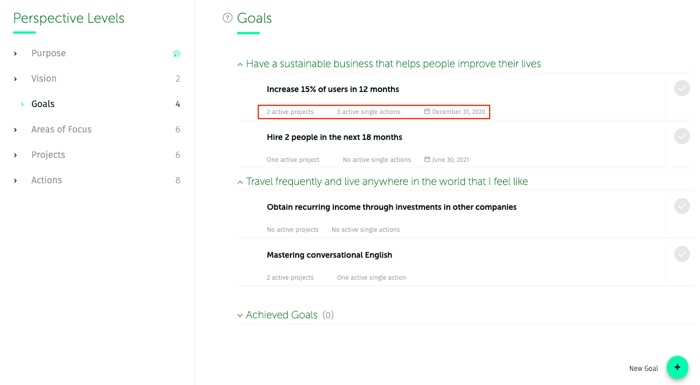ADVANCED TUTORIALS
Perspective
The GTD’s Six-level Model for Reviewing Your Own Work helps you understand the foundations of your personal and professional life, giving you clarity about the priorities that should guide your decisions.
It’s a hierarchical model of priorities in which each level supports and aligns with those above it.
Defining these six levels of perspective helps you distinguish what truly matters, focus your time on what’s most meaningful, and ultimately move toward where you want to go.
1. Purpose
Each level includes extra information to help you clearly understand what it represents (1).
Your purpose gives meaning to your life, though discovering it isn’t always easy. It requires reflection and self-knowledge. You don’t need to define it perfectly right away. Start by writing a brief description and refine it over time until it truly reflects who you are.
Everything else—your vision, goals, projects, and actions—flows from this purpose and should move you toward it.
To support your purpose, at this level you have a Principles and Values section so that you can express and always keep in mind the principles and values that will determine how you do things. They’ll guide you as you make decisions and handle challenges. Use the button (2) to add principles and values that support your life purpose (use the “save” button to save the data later).

2. Vision
Your vision is the picture you have of yourself three to five years from now. Based on this vision, your brain will establish the goals needed to make it a reality.
Defining the vision involves thinking about how you want to be in the future, both personally and professionally. At minimum, you’ll need a few clear statements to describe it.
You can create a new vision statement with the button (1) and edit the existing statements by clicking on an item in the list (2). When a vision becomes reality, you can mark it as ‘achieved’ (3). The visions already achieved will appear in the list (4).
The number of Goals related to each Vision is displayed. By clicking on that link (5) you will be able to see those goals in detail (at level 3).

3. Goals
Goals are the outcomes you want to accomplish in the medium term, usually one or two years, both in your personal life and at work. Your goals should be aligned with your vision, so try to link each goal to a higher vision.
Goals are shown grouped by vision. Each goal shows the number of projects and single actions associated with it. By clicking on those links you can see the projects (at level 5) and actions (at level 6) in detail. The goal deadline is also shown, if there is one.

4. Areas of Focus
Areas of Focus are the different facets of your life that you want to improve or maintain at a good level. In your work, they may be the different roles you have acquired, like customer service, planning, design, management, etc. In your personal life, they can include family, health, finances, self-improvement, etc.
Although they’re ranked fourth in the six-level hierarchy, there’s no strict hierarchical dependence on the levels above. An Area of Focus can affect multiple Goals, and a Goal may involve several Areas of Focus.
This section works just like the Goals section, except that Areas of Focus are grouped into two categories—Personal and Professional—and displayed with color coding.
Areas of Focus can’t be ‘achieved’ like goals or visions, since they represent ongoing commitments rather than temporary targets. But you have the possibility of disabling them, in case one of them gets out of your life and you don’t want to eliminate it completely.

For each area, you can choose whether it’s personal or professional (1) and assign a color to represent it (2).

All actions related to an Area of Focus will be shown in the lists with their color. Choose colors that feel right to you and use similar ones for related areas, so your brain quickly learns the color patterns and you can spot related actions faster.
5. Projects
A Project is any result that requires more than one action to be performed.
This section displays all active projects—those in progress or on hold—and a filter tool at the top so you can see which ones have an Area of Focus and/or a Goal assigned. Make sure each project is linked to at least one higher level of perspective.
In each project the percentage executed so far is indicated. You can mark as “completed” those that have no pending action. You can also edit any project by clicking on it.

6. Actions
This section lists all active standalone Actions —those not part of a project and found in the Calendar (1), Next Actions (2) or Waiting For (3) lists. The icon to the left of each action indicates which list it belongs to.
Ensure your actions stay aligned with the higher levels of perspective.

Focus Tool
Once your Perspective levels are defined, you can filter your actions and projects lists by Goals and Areas of Focus—or, at a higher level, by Vision or by Personal/Professional areas.
To do this, click the target-shaped icon in the top navigation bar and choose the filter you want to apply.




